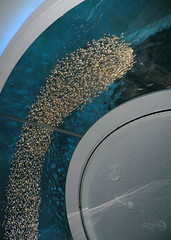
In a community ants can solve complicated tasks
On its own, an ant is not particularly clever. But in a community, the insects can solve complicated tasks. Researchers intend to put this swarm intelligence to use in the logistics field. Lots of autonomous transport shuttles would provide an alternative to traditional materials-handling technology.
The orange-colored vehicle begins moving with a quiet whirr. Soon afterwards the next shuttles begin to move, and before long there are dozens of mini-transporters rolling around in the hall. As if by magic, they head for the high-rack storage shelves or spin around their own axis. But the Multishuttle Moves® – is the name given to these driverless transport vehicles – are not performing some robots‘ ballet. They are moving around in the service of science. At the Fraunhofer Institute for Material Flow and Logistics IML in Dortmund, Germany, researchers are working to harness swarm intelligence as a means of improving the flow of materials and goods in the warehouse environment. In a research hall 1000 square meters in size, the scientists have replicated a small-scale distribution warehouse with storage shelves for 600 small-part carriers and eight picking stations. The heart of the testing facility is a swarm of 50 autonomous vehicles. “In the future, transport systems should be able to perform all of these tasks autonomously, from removal from storage at the shelf to delivery to a picking station. This will provide an alternative to conventional materials-handling solutions,“ explains Prof. Dr. Michael ten Hompel, executive director at IML.
But how do the vehicles know what they should transport, and where, and which of the 50 shuttles will take on any particular order? “The driverless transport vehicles are locally controlled. The ›intelligence‹ is in the transporters themselves,“ Dipl.-Ing. Thomas Albrecht, head of the Autonomous Transport Systems department explains the researchers‘ solution approach. “We rely on agent-based software and use ant algorithms based on the work of Marco Dorigo. These are methods of combinational optimization based on the model behavior of real ants in their search for food.“ When an order is received, the shuttles are informed of this through a software agent. They then coordinate with one another via WLAN to determine which shuttle can take over the load. The job goes to whichever free transport system is closest.
The shuttles are completely unimpeded as they navigate throughout the space – with no guidelines. Their integrated localization and navigation technology make this possible. The vehicles have a newly developed, hybrid sensor concept with signal-based location capability, distance and acceleration sensors and laser scanners. This way, the vehicles can compute the shortest route to any destination. The sensors also help prevent collisions.
The vehicles are based on the components of the shelf-bound Multishuttle already successfully in use for several years.
via Fraunhofer Institute ᔥ
Bookmark this page for “swarm intelligence” and check back regularly as these articles update on a very frequent basis. The view is set to “news”. Try clicking on “video” and “2” for more articles.








